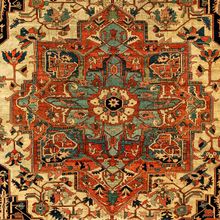Heriz Rug
| Heriz Rug | |
|---|---|
 Design of Heriz Rug (Rugman) | |
| General information | |
| Name | Heriz Rug |
| Original name | قالی هریس |
| Alternative name(s) | Heriz Carpet (Serapi Rug) |
| Origin | |
| Category | Village |
| Technical information | |
| Common designs | Lachak Toranj, Geometric |
| Common colors | Red, Brown, Green, Navy Blue, Pink, Blue, Ivory |
| Dyeing method | Natural, Synthetic |
| Pile material | Wool |
| Foundation material | Cotton |
| Knot type | Symmetrical (Turkish) |
Heriz Rug originate from Heriz, located in the Province of Azerbaijan. Heriz is a very important production center of Persian carpets. Hand woven by the Turkish inhabitants of Heriz, the creation of Persian carpets is their primary source of income and this time honored craft is passed down from generation to generation. The skilled artisans still use basically the same technique as that of the Mongols who invaded the region in the 13th century. Heriz rugs are the most sought after of the tribal rugs. Antique Heriz Persian carpets called Serapi (woven before 1900) are extremely valuable and highly collectable. Most weavers use the Turkish double knot, while the KPSI (knots per square inch) will vary depending upon the quality of the carpet. Heriz Persian carpets from the town's workshops are of better quality than those from the remote mountain villages. The silk Persian carpets are exceptionally finely knotted and are both very rare and absolutely exquisite.
History
Heriz, a town in the East Azerbaijan Province of northwestern Iran, was a famous weaving village during the nineteenth and twentieth centuries. The population is Azeri tribe in origin and speaks a Turkic dialect. Heriz sits at the foot of the Sabalan Mountain and has a cold climate for much of the year.
Heriz rugs and carpets are known in the market from the early nineteenth century. The weavers of Heriz are credited with being the first in Persia to produce room-size and oversize carpets with rustic, nomadic designs. Heriz carpets are well known in the world market and coordinate with the interiors of many European and American homes. They are also in demand for the domestic market, especially in the Azerbaijan Province. Heriz carpets are known to be durable floor coverings.[1]
In the nineteenth century American carpet dealers used the term serapi for Heriz wool pile carpets because it was similar to the medallion style of the Mexican serape (blanket or shawl).
Many villages surrounding Heriz adopted the popular designs of Heriz in the last quarter of the nineteenth century in response to world market demand. Generally, the weavings of these villages are grouped as Heriz carpets abroad, but each village is known individually by name in the Iranian market. The popular villages include AHAR, BILVERDI, GORAVAN, KARADJA, MEHRABAN, SHARABIAN, and SINSARAI. The famous weaving village of BAKSHAISH also switched to Heriz designs for better marketing purposes by the turn of the twentieth century. Although the designs were similar to Heriz, all of these villages possessed easily identifiable characteristics with their chosen motifs, color, and qualities.[2]
Materials
Foundation and Pile
The weavings have a cotton foundation and a wool pile. Heriz weavers also made rugs with a silk foundation and a silk pile.[3]
Techniques and structures
Color and dyeing
Motifs and Designs
Weaving techniques
The Turkish (symmetric) knot is always employed.[4]
See also
References
Bibliography
Abraham Levi Moheban, (2015), The Encyclopedia of Antique Carpets: Twenty-Five Centuries of Weaving, NewYork: Princeton Architectural Press.